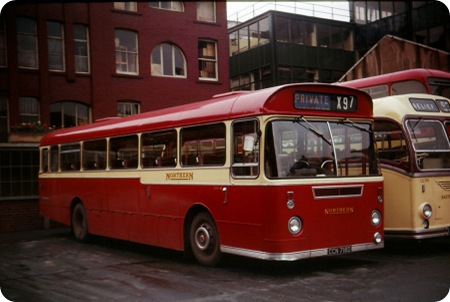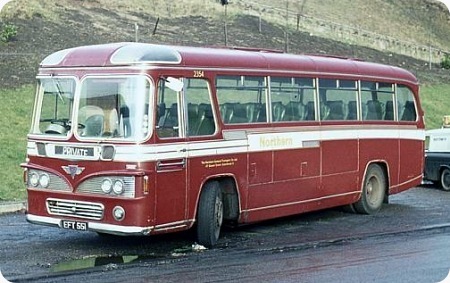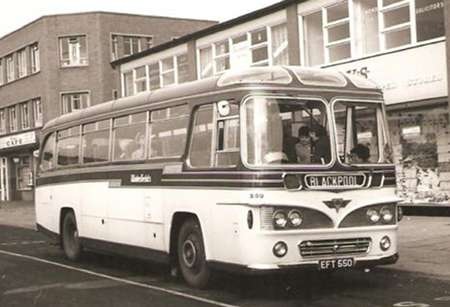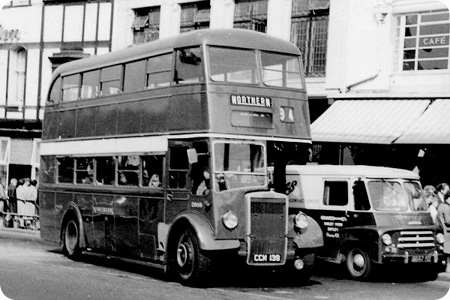
The Northern General Transport Company
1966
Leyland Leopard PSU3/3R
Marshall DP49F
Photo taken at Wellington Street bus station Leeds. The X97 route was Liverpool to Newcastle via Leeds obviously.
Information for this photo was found on the ‘Bus Lists on the Web’ website a very good site indeed can be seen here.
05/01/12 – 07:24
I think that the air intake below the windscreen of the Northern General Leopard indicates it was fitted with the UHV (underfloor heating & ventilation) system designed in conjunction with BET, supposedly a fully automatic system with temperature sensors and air operated valves and flaps opening and closing various air ducts through which fresh or recirculated air passed in theory. In practice it was a very different matter as the only automatic thing was both driver and passengers were very cold in winter and very very hot in summer there being few opening windows and two permanently open roof vents with plastic trays underneath to disperse the incoming air. The worst aspect from the drivers point of view was that there wasn’t a motor and fan in the demister the system relied on the forward motion of the vehicle you can imagine how well this worked on a local stopping service. I encountered this system when working for Southdown who also had it fitted to a batch of Plaxton bodied coaches, fitted with vinyl covered seats, there were of course no opening windows and only the two roof vents already mentioned plus two more under the driver or passenger control, no Jet Vent blowers were fitted and of course the same inadequate demister system which still did not work on long runs These vehicles were known as "sweat boxes" very inappropriate in winter and loathed by drivers and passengers alike.
Diesel Dave
07/01/12 – 08:52
How times have/haven’t changed. Fully automatic heating and ventilation systems are now commonplace, but they still don’t work!
Peter Williamson
07/01/12 – 10:15
…..problem is, passengers insist on breathing whatever the temperature or weather conditions.
David Oldfield
31/01/12 – 09:23
There was one automatic heating and ventilation system that worked very well and that was the one fitted to the A series Leyland National providing the filters were kept clear of the inevitable debris that collected it was very reliable. It appeared to defy the fact that hot air rises with the outlets in the roof coving,which had the added bonus of the demister clearing from the top of the screen first, much better for the driver, in fact the whole bus was comfortable. The B series was no better than any other vehicle with underseat box heaters. Although much maligned the National was not a bad bus to drive, personally I thought the Mk 2 with the 680 engine was one of the best buses I ever drove. That may stir up some controversy.
Diesel Dave
31/01/12 – 15:29
Because the National was integral it was considered as a whole. The 500 series engine, especially the 510, was abominable and overshadowed the fact that the body – admittedly very spartan – was very good. The National 2 was what it ought to have been from the start – and a worthy successor to the vehicle it killed off (or murdered?) the Bristol RE. I agree with you fully about the National 0680 – but what about the TL11 version, or for that matter the Gardner?
David Oldfield
31/01/12 – 16:35
There is a nice essay on the 500 and its problems on the AROnline site here: //www.aronline.co.uk/
Gary T
31/01/12 – 16:38
Are Leyland Nationals too late for this site? I never got too close to them for some reason, but they were certainly quirky – the Meccano body must have been the death-knell of "coachbuilding" -and they could also be used on the railways! Can any of our resident panel explain: -why they sounded like industrial food mixers (which engine was that)? -why they emitted clouds of diesel particulates which would put them off the road these days (ditto?) and -what that pretend (?) air conditioning unit/1930’s luggage box on the roof was?
Joe
01/02/12 – 07:56
Yes Joe, that’s the famous 510 engine you’re talking about – and they are strictly "too late". The fixed head was novel, and extremely unreliable, smoky and sounded like a can of marbles. The roof box was an advanced, but expensive, heating unit.You could, however, get me really wound up about the LEZ (London’s low emission zone). You only need eyes to see the filth which can come out of modern "clean" vehicles and some TRC Tigers and Leopards (to name but two)would not "pass the test" and yet are possibly cleaner. [You certainly don’t choke in a smoke cloud behind them!]
David Oldfield
01/02/12 – 07:57
I have to take issue with Diesel Dave on the heating system defying normal laws of physics. Things may have been better in the cab but I recall many instances of getting on what I thought was a ‘warm’ National, passing under the warm air curtain at the door and sitting down. After a while your feet told you exactly where all the cold air had gone! There was a real temperature gradient. I would agree about the demisting effect though, even the saloon windows had less of a propensity to steam up.
David Beilby
01/02/12 – 07:58
I cant comment on the MK2 National as I’ve never driven one, but the early MK1’s were an abortion. When we first got them at Percy Main they were sometimes used on dual crew, and the conductors claimed that when they went round a corner they leaned over that much that they were almost walking on the windows. They soon became known as the ‘kick start buses’ as some of the myriad of sensors on the lower inspection panels were so touchy that a hefty boot had to be administered to ensure that contact was made and the vehicle would start, the steering was far too light and had no feel, they scrubbed off front tyres at an alarming rate, and on a wet road, if the vehicle went in the same direction that the wheels were pointing it was more by luck than judgment, as for the heating, on cold winter days you could be sitting with sinus trouble in you nose and frostbite in your feet, they must have had some good points but off hand I cant think of any.
Ronnie Hoye
01/02/12 – 08:00
Well I can’t answer Joe’s questions but I do remember very well the roof mounted air conditioning and heating system with outlets along the length of the interior, just above the cove panels, which quickly became blackened by the warm air, or should I say fumes of the heating. It’s astonishing that it never occurred to the designers that the heat (such as it was) would collect in the roof whilst your feet were like two blocks of ice on the floor!
Chris Barker
01/02/12 – 08:00
Thanks Gary: answers to my questions are in your quoted article (except the roofbox which was presumably the heating….)… and I thought it was just the cars (I had a Princess & lived- never to buy BL again). Let’s get back to the good old days…
Joe
01/02/12 – 08:01
As an apprentice working for West Yorkshire Road Car when they were still very much a Bristol – ECW – Gardner operator, I noted that anything built by Leyland was viewed with the deepest suspicion by the old guard. So when WY’s first Nationals arrived, and caused major headaches for the engineering staff, those deep suspicions seemed totally justified. ("We’re all doomed – aye doomed!" to quote a well-known Scotsman).
As Diesel Dave comments, the ‘A-Series’ heating and ventilation system worked very well, even in the depths of winter. The system also provided a ‘hot air curtain’ (Leyland parlance) over the entrance to reduce heat loss when the doors opened. The 510 engine was its Achilles heel as David states, and in the early days engines were covering less than 100,000 miles before the big end and main bearings disintegrated. However, following various Leyland modifications – large and small – WY examples were achieving well over 300,000 miles between overhauls in their later years. (Regarding your comment about the National killing off the RE David, three of WYs RELLs suffered the indignity of being fitted with 500 engines when new in 1970, as part of the National development programme. To add insult to injury, they still sported SRG 118-120 as their fleet numbers, even though they did not receive Gardner 6HLX transplants until a few years later, by which time they had become 1318-1320).
With regard to Joe’s queries, the ‘industrial food mixer’ sound may have been due to its engine design, being a ‘small’ unit developing 180 bhp in the National and capable of greater outputs in other applications. Cam lobes were very pointed in profile compared to a 680 or Gardner engine for example, meaning that the 510 valves snapped shut faster. Also, if memory serves correctly, the injector pressures were higher on the 510 too, adding to the cacophony. The engine was also of overhead camshaft layout, with a train of large, straight-cut gears supplying the drive from the crankshaft. The smoke problem certainly persisted, despite revised injectors, revised fuel pump settings and a different type of turbocharger. I personally wondered whether the air inlet manifold may have been the culprit, as this was simply a rectangular pressed steel box bolted onto the side of the engine. Gardner turbo engines in contrast had nicely shaped manifolds to aid the flow of air being forced into the engine, whereas the 510’s affair could not have provided anywhere near such a smooth airflow in comparison.
As for the ‘luggage box on the roof’ Joe, that housed the automatic heating and ventilation system mentioned by Diesel Dave. The system was generally pretty reliable, but I do recall one occasion sitting towards the rear of a Mk I National en route to Bradford, and being dripped on every time the bus came to a halt, or went down a gradient! Needless to say the beast had sprung a leak, and the driver had it signed off at the Interchange, but I did wonder what fellow passengers thought about the roof leaking…….
Brendan Smith
01/02/12 – 16:21
Gentlemen, as someone who was never employed in the bus industry, I am fascinated to read that the commercial vehicle side of "BL" was every bit as bad as the car division. In 1971 I bought a new Morris 1300GT and it rained the first day I had it. Next morning I found around a gallon of water in the boot so drove back to the dealers where I was told to "Drill ‘ole in the floor and it won’t fill up then", Obviously a BL man to the core!
From memory, didn’t the Nationals also have a tendency to catch fire as I clearly recall one suffering a burnt out rear in Ashton Way, Keynsham and also reading of two or three others going the same way. I know I thought them very cheap and basic things so much so that I near enough gave up any interest in anything later than 1972 onwards!
I shall look out for any preserved examples and try to get a "sound effects" recording but from what you all say, finding one with a "510" engine still running seems unlikely!
Richard Leaman
01/02/12 – 16:22
Yes Brendan, and there were rather too many VRs with the 510 as well. Gary Ts link to aronline includes a query/comment about the New Zealand REs having the 510. This was yet another example of Leyland "choice" – you choose to take what Leyland "offered" or you choose to go elsewhere!
David Oldfield
02/02/12 – 07:10
The Leyland engine option in the VR was the naturally-aspirated 501 rather than the turbocharged 510. I expect operators had similar problems with them, but from a passenger point of view they were an absolute delight. They were very quiet, with none of the National’s clatter (which I believe came from a cooling fan coupling or something like that), and unlike the kick-you-in-the-back 6LXB, the power delivery was always ultra-smooth no matter how heavy the driver’s boot. And when coupled to the 5-speed gearbox they could motor too.
Peter Williamson
02/02/12 – 07:11
Richard, British Leyland shouldn’t be confused with Leyland Motors; the latter had stiff competition in the bus market from AEC Bristol Daimler and Guy, ‘Albion were already a subsidiary of Leyland’ and whist it’s fair to say they all had their share of lemons, it was a very competitive market and in the main they were all good vehicles, there were other manufacturers in the market but the companies I’ve mentioned all became part of BL. Before they eventually disappeared, ‘or to be more accurate were killed off’ most names became little more than badge engineered versions of the same BL know best product. BL had a guaranteed market as long as National Bus company was in existence, but as soon as deregulation came they found that their product was no longer in demand. An example of BL’s policy can be seen in the car market, pre BL, Rover’s were built up to a standard, then they became part of BL who in their wisdom or otherwise decided it would be a good idea to put a Rover badge on a Metro. Enough said
Ronnie Hoye
03/02/12 – 06:34
Just after West Yorkshire had converted its three experimental 500-engined RELLs (1318-20) to Gardner 6HLXs, in pursuit of standardisation and improved reliability, guess what came next? Yes, three VRT3s with ‘National’ engines fitted! Numbered 1971-73, these had the vertical 501 versions with turbochargers. (If memory serves correctly Peter I seem to recall that the naturally-aspirated versions were 500s in either vertical or horizontal form, but don’t ask me why as Leyland’s logic was a law unto itself in those days!). Reliability-wise they were marginally better than the 510s, but they suffered oil leaks, and engine vibrations caused problems with gearboxes, engine and gearbox mountings, and exhaust systems. Needless to say they too were converted to Gardner power (6LXB) a few years later. Viewed from the engine compartment, the 501 looked like a mass of pipework with an engine attached somewhere beneath. I think Leyland had tried to place everything on the accessible side of the engine for maintenance purposes, such as the injection pump, compressor, heat exchanger etc. More often than not however, it seemed that you couldn’t remove the faulty bit without first removing half a barrow load of other bits to get to it! As Peter states though, from a passenger viewpoint they did seem fairly smooth and quiet in the VRTs, but I’m afraid I’ll have to side with David that there were far too many VRTs with the ‘headless wonder’ fitted. Poor old East Yorkshire appeared to have lots, which seemed most unfair.
Brendan Smith
01/11/13 – 08:07
One Leopard I remember fondly is MRU 551W, a PSU5C/4R with Plaxton Supreme IV C57F bodywork new to Marchwood of Totton. I used to drive for Country Lion of Northampton. They operated it from May 1986 until July 1987. Most of the drivers could not master the Pneumocyclic Gearbox, which was why it went in PX for a Volvo B10M Duple 320 C57F in July 1987. Shame, as it was a lovely motor to drive.
Stemax1960
 Vehicle reminder shot for this posting
Vehicle reminder shot for this posting
01/11/13 – 13:54
I loved the National. For three years in the 1970s the breed provided me with a great deal of commission as BL sought to master the monster it had created. I was supplying the BL spares operation in Chorley and the Workington factory with tags, tickets, labels and plastic ties and almost from first entry into service of the production models those products relating to the National showed a marked increase in demand.
It has to be said that "real" Leyland employees at Chorley hated the National for whilst it provided a constant stream of work, it also provided a constant stream of problems as sometimes the production of spares, many from outside suppliers, lagged behind the demand and the yard and workshops at Chorley always seemed to have more Nationals than any other Leyland product awaiting investigation.
Peter Williamson is quite correct in blaming the cooling fan coupling for much of the clatter.
Phil Blinkhorn






